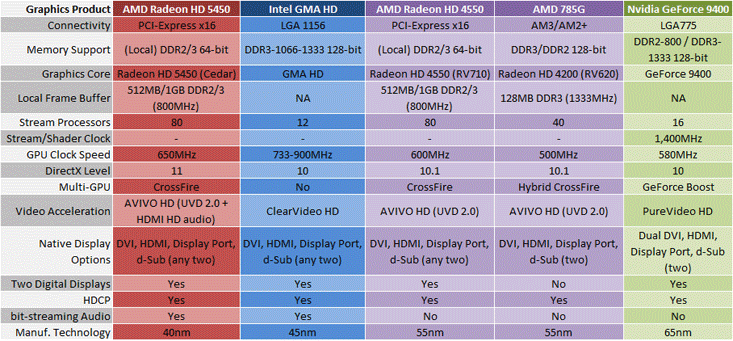Radeon HD 5450: Low Power, HTPC Heaven?
Manufacturer: ATIUK Price (as Reviewed): £38.31 (inc. VAT) for the 512MB version
US Price (as Reviewed): $54.99 (ex. Tax) for the 512MB version
At under £40 the Radeon HD 5450 is probably one of the cheapest graphics cards we've ever reviewed, so generating the hundreds of FPS in Crysis clearly isn't its forte. This maybe ATI's most inexpensive offering but its advanced set of features, combined with a budget AMD system, could make it the perfect ingredient for a killer Home Theatre PC. So much so, that we thought Intel's reign with its GMA HD could be exceptionally short lived.
The HD 5450 brings 'DirectX 11 Gaming' to the table, but take that capacity with a pinch of salt given its meagre horsepower. Its biggest advantage is actually the second generation of Universal Video Decoder, (UVD2.2) that now includes support for HDMI 1.3a and bit-streaming for all HD audio. Just like the rest of the 5000 series, now you can have Dolby TrueHD and DTS MasterHD over HDMI: a necessary addition for serious Home Theatre enthusiasts.
In addition to this, UVD2.2 has full support for BD-Live; including picture in picture, hardware post processing of resizing, denoise, deinterlacing, inverse telecine, 12-bit 'Deep Colour', and general improved compatibility with MPEG2, AVCHD (H.264) and VC1 codec playback. We've read AMD does include support for dual audio stream processing, but we cannot find whether they are HD-capable or not. Either way, AMD's latest UVD pretty much matches Intel's GMA HD on paper.
Looking at the table above, we can see there's not many changes compared to the older HD 4550, except as regards the audio and manufacturing, which has moved from TSMC's 55nm to 40nm node. This has dropped power use under load by about 6W down to 19.1W. When idle it takes just 6.4W - that's next to nothing! The memory is still limited to a 64-bit interface, using either DDR2 or DDR3 modules, however DDR3 IC prices have dropped so this should now be the standard across all HD 5450s. Compared to the 785G chipset's onboard graphics and there's twice the stream processors (80), in addition to an extra 150MHz core clock speed too, as well as a three generation (785G's GPU is ~HD 2000/3000 series hardware) difference in core architecture.
In terms of the reference model from ATI, it can be a half height graphics card if you remove the D-Sub option, but ATI didn't provide us with an extra bracket. If you need it, check that the ATI partner does before you buy - for budget graphics cards where margins are thin, many partners will avoid giving us an extra bracket in the box: you will probably only get a card and driver disc.
The big red heatsink also means its dual slot, but passively cooled certainly wins our favour compared to the fans a lot of ATI partners seem to be using. If you have the space - go passive - and you will thank us for removing an whiney, annoying little fan from your PC. So far we've only seen Sapphire and HIS do the passive option and it even remains single slot - win-win! Do note though: Sapphire sells (useful) HDMI and (useless) DiaplayPort versions separately, at probably different cost since HDMI requires a license to use, so make sure you choose the right one (HDMI) before you buy!
For HTPC guys, it's potentially a perfect upgrade: for example, start off with just a 785G motherboard and should you get more serious drop in the ~£40 HD 5450 512MB. Ignore the 1GB at £10-15 more because it makes the HD 5450 extortionately expensive for what it offers. The extra memory will certainly not benefit your HTPC playback and we strongly doubt it will benefit your gaming, since the card cannot shift that amount of data fast enough to be worthwhile anyway.
We were keen to see if the latest passively cooled graphics card adds anything to a budget PC that uses onboard graphics. By alleviating the demands of the IGP on main system memory it should, in theory, increase general productivity as well as gaming performance.

MSI MPG Velox 100R Chassis Review
October 14 2021 | 15:04
















Want to comment? Please log in.